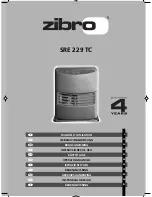
lp-772 Rev. 000 Rel. 000 Date 3.17.21
8
F. Temperature and Pressure Relief Valve
For protection against excessive pressures and temperatures in this
water heater, install temperature and pressure protective equipment
as required by local codes, but not less than a combination T&P valve
meeting the requirements for
Relief Valves and Automatic Gas Shutoff
Devices for Hot Water Supply Systems, ANSI Z21.22B / CSA 4.4-M99
by
a nationally recognized testing laboratory that maintains periodic
inspection of production listed equipment and materials. This valve
must be marked with a maximum set pressure not to exceed the
marked maximum working pressure of the water heater. Install the
T&P valve into the top or side opening provided and marked for this
purpose on the water heater. The T&P valve must be plumbed down so
discharge can exit at least 6” above the structural floor. The relief line
cannot be in contact with any live electrical parts.
Figure 3 - T&P Relief Valve Operation
Do not thread a cap or plug into the relief valve or block relief
valve outlet line under any circumstances! Explosion and property
damage, serious injury, or death may result.
The pressure relief rating of the relief valve MUST NOT EXCEED
150 PSI, and not exceed the maximum working pressure of the
water heater as marked on the rating plate. Failure to follow these
instructions could result in property damage, severe personal injury,
or death due to scalds.
To avoid water damage or scalding due to relief valve operation:
•
Discharge line must be connected to relief valve outlet and
run to a safe place of disposal. Terminate the discharge line
in a manner that will prevent possibility of severe burns or
property damage should the relief valve discharge.
•
Discharge line must be as short as possible and the same size
as the valve discharge connection throughout its entire length.
•
Discharge line must pitch downward from the valve and
terminate at least 6” above the floor drain, making discharge
clearly visible.
•
The discharge line shall terminate plain, not threaded, with a
material serviceable for temperatures of 375
o
F or greater.
•
Do not pipe discharge to any location where freezing could
occur.
•
No valve may be installed between the relief valve and heater
or in the discharge line. Do not plug or place any obstruction
in the discharge line.
•
Test the operation of the relief valve after filling and
pressurizing the system by lifting the lever. Make sure the
valve discharges freely. If the valve fails to operate correctly,
immediately replace with a new properly rated relief valve.
•
Test T&P valve at least once annually to ensure the waterway
is clear. If valve does not operate, turn the heater “off” and call
a plumber immediately.
•
Take care whenever operating relief valve to avoid scalding
injury or property damage.
FAILURE TO COMPLY WITH THE ABOVE GUIDELINES COULD RESULT
IN FAILURE OF RELIEF VALVE OPERATION, RESULTING IN POSSIBILITY
OF SUBSTANTIAL PROPERTY DAMAGE, SEVERE PERSONAL INJURY,
OR DEATH.
RE-INSPECTION OF T&P RELIEF VALVES: T&P valves should be
inspected AT LEAST ONCE EVERY THREE YEARS, and replaced if
necessary,
by a licensed plumbing contractor or qualified service
technician to ensure that the product has not been affected
by corrosive water conditions and to ensure that the valve and
discharge line have not been altered or tampered with illegally.
Certain naturally occuring conditions may corrode the valve and
its components over time, rendering the valve inoperative. Such
conditions can only be detected if the valve and its components
are physically removed and inspected.
Do not attempt to conduct
an inspection on your own.
Contact your plumbing contractor
for a re-inspection to assure continued safety.
FAILURE TO RE-INSPECT THE T&P VALVE AS DIRECTED COULD
RESULT IN UNSAFE TEMPERATURE AND/OR PRESSURE BUILD-
UP WHICH CAN RESULT IN PROPERTY DAMAGE, SERIOUS
PERSONAL INJURY, OR DEATH.
G. Scalding
An ASSE 1017 or ASSE 1070 temperature limiting or mixing valve
is recommended in installations servicing disabled or elderly
persons, or children. Mixing valves can reduce but do not eliminate
the risk of scalding.
To avoid scalding:
•
Set the water heater set point temperature as low as
possible.
•
Feel water before bathing or showering.
•
If thermostatic valves are required, use devices specifically
designed for such purpose. Install these devices in
accordance with instructions provided by the manufacturer.
Failure to install a temperature limiting or mixing valve and
follow these instructions could result in property damage, severe
personal injury, or death due to scalds.
This water heater can
deliver scalding water. Be
careful whenever using
hot water to avoid scalding
injury. Certain appliances
such as dishwashers and
automatic clothes washers
may require increased
water temperatures. By
setting the thermostat
on this heater to obtain
the increased water
temperature required by
these appliances you may
create the potential for
scald injury.
To protect against injury,
install a mixing valve in the
water system. This valve
will reduce point of use
discharge temperatures by
mixing cold and hot water
in branch supply lines.
Such valves are available
from your local plumbing
supplier.





































